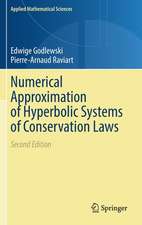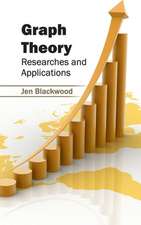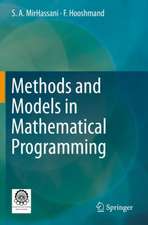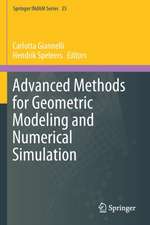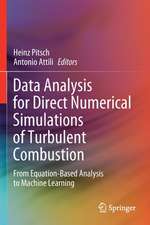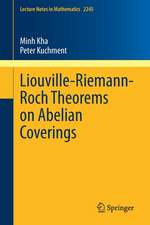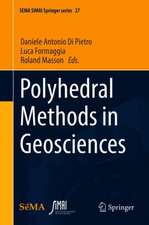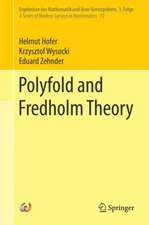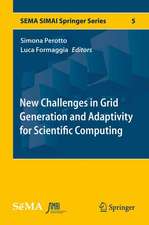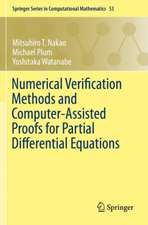Introduction to Partial Differential Equations with MATLAB: Applied and Numerical Harmonic Analysis
Autor Jeffery M. Cooperen Limba Engleză Hardback – 18 dec 1998
| Toate formatele și edițiile | Preț | Express |
|---|---|---|
| Paperback (1) | 512.21 lei 6-8 săpt. | |
| Birkhäuser Boston – 31 oct 2012 | 512.21 lei 6-8 săpt. | |
| Hardback (1) | 431.76 lei 3-5 săpt. | +38.07 lei 7-11 zile |
| Birkhäuser Boston – 18 dec 1998 | 431.76 lei 3-5 săpt. | +38.07 lei 7-11 zile |
Din seria Applied and Numerical Harmonic Analysis
-
 Preț: 399.29 lei
Preț: 399.29 lei - 20%
 Preț: 673.02 lei
Preț: 673.02 lei - 19%
 Preț: 443.08 lei
Preț: 443.08 lei -
 Preț: 412.57 lei
Preț: 412.57 lei - 15%
 Preț: 550.04 lei
Preț: 550.04 lei - 15%
 Preț: 653.98 lei
Preț: 653.98 lei - 18%
 Preț: 1014.28 lei
Preț: 1014.28 lei - 15%
 Preț: 647.92 lei
Preț: 647.92 lei -
 Preț: 413.37 lei
Preț: 413.37 lei - 15%
 Preț: 648.74 lei
Preț: 648.74 lei - 15%
 Preț: 654.77 lei
Preț: 654.77 lei - 15%
 Preț: 636.80 lei
Preț: 636.80 lei - 15%
 Preț: 532.89 lei
Preț: 532.89 lei - 15%
 Preț: 646.62 lei
Preț: 646.62 lei - 15%
 Preț: 653.98 lei
Preț: 653.98 lei -
 Preț: 397.38 lei
Preț: 397.38 lei - 15%
 Preț: 656.43 lei
Preț: 656.43 lei - 15%
 Preț: 661.97 lei
Preț: 661.97 lei - 18%
 Preț: 957.13 lei
Preț: 957.13 lei - 24%
 Preț: 829.71 lei
Preț: 829.71 lei -
 Preț: 398.35 lei
Preț: 398.35 lei - 20%
 Preț: 569.85 lei
Preț: 569.85 lei -
 Preț: 392.21 lei
Preț: 392.21 lei - 18%
 Preț: 1121.76 lei
Preț: 1121.76 lei - 18%
 Preț: 1006.72 lei
Preț: 1006.72 lei -
 Preț: 387.75 lei
Preț: 387.75 lei - 15%
 Preț: 653.98 lei
Preț: 653.98 lei - 20%
 Preț: 567.32 lei
Preț: 567.32 lei - 20%
 Preț: 573.76 lei
Preț: 573.76 lei -
 Preț: 406.80 lei
Preț: 406.80 lei -
 Preț: 387.38 lei
Preț: 387.38 lei - 5%
 Preț: 1168.71 lei
Preț: 1168.71 lei -
 Preț: 400.85 lei
Preț: 400.85 lei -
 Preț: 398.15 lei
Preț: 398.15 lei - 15%
 Preț: 644.49 lei
Preț: 644.49 lei - 19%
 Preț: 575.82 lei
Preț: 575.82 lei - 15%
 Preț: 703.71 lei
Preț: 703.71 lei - 20%
 Preț: 334.71 lei
Preț: 334.71 lei - 15%
 Preț: 525.54 lei
Preț: 525.54 lei -
 Preț: 405.06 lei
Preț: 405.06 lei - 15%
 Preț: 536.96 lei
Preț: 536.96 lei
Preț: 431.76 lei
Preț vechi: 520.19 lei
-17% Nou
Puncte Express: 648
Preț estimativ în valută:
82.62€ • 86.66$ • 68.78£
82.62€ • 86.66$ • 68.78£
Carte disponibilă
Livrare economică 11-25 martie
Livrare express 25 februarie-01 martie pentru 48.06 lei
Preluare comenzi: 021 569.72.76
Specificații
ISBN-13: 9780817639679
ISBN-10: 0817639675
Pagini: 541
Ilustrații: XV, 541 p.
Dimensiuni: 155 x 235 x 29 mm
Greutate: 0.93 kg
Ediția:1998
Editura: Birkhäuser Boston
Colecția Birkhäuser
Seria Applied and Numerical Harmonic Analysis
Locul publicării:Boston, MA, United States
ISBN-10: 0817639675
Pagini: 541
Ilustrații: XV, 541 p.
Dimensiuni: 155 x 235 x 29 mm
Greutate: 0.93 kg
Ediția:1998
Editura: Birkhäuser Boston
Colecția Birkhäuser
Seria Applied and Numerical Harmonic Analysis
Locul publicării:Boston, MA, United States
Public țintă
ResearchCuprins
1 Preliminaries.- 1.1 Elements of analysis.- 1.2 Vector spaces and linear operators.- 1.3 Review of facts about ordinary differential equations.- 2 First-Order Equations.- 2.1 Generalities.- 2.2 First-order linear PDE’s.- 2.3 Nonlinear conservation laws.- 2.4 Linearization.- 2.5 Weak solutions.- 2.6 Numerical methods.- 2.7 A conservation law for cell dynamics.- 2.8 Projects.- 3 Diffusion.- 3.1 The diffusion equation.- 3.2 The maximum principle.- 3.3 The heat equation without boundaries.- 3.4 Boundary value problems on the half-line.- 3.5 Diffusion and nonlinear wave motion.- 3.6 Numerical methods for the heat equation.- 3.7 Projects.- 4 Boundary Value Problems for the Heat Equation.- 4.1 Separation of variables.- 4.2 Convergence of the eigenfunction expansions.- 4.3 Symmetric boundary conditions.- 4.4 Inhomogeneous problems and asymptotic behavior.- 4.5 Projects.- 5 Waves Again.- 5.1 Acoustics.- 5.2 The vibrating string.- 5.3 The wave equation without boundaries.- 5.4 Boundary value problems on the half-line.- 5.5 Boundary value problems on a finite interval.- 5.6 Numerical methods.- 5.7 A nonlinear wave equation.- 5.8 Projects.- 6 Fourier Series and Fourier Transform.- 6.1 Fourier series.- 6.2 Convergence of Fourier series.- 6.3 The Fourier transform.- 6.4 The heat equation again.- 6.5 The discrete Fourier transform.- 6.6 The fast Fourier transform (FFT).- 6.7 Projects.- 7 Dispersive Waves and the Schrödinger Equation.- 7.1 Oscillatory integrals and the method of stationary phase.- 7.2 Dispersive equations.- 7.3 Quantum mechanics and the uncertainty principle.- 7.4 The Schrödinger equation.- 7.5 The spectrum of the Schrödinger operator.- 7.6 Projects.- 8 The Heat and Wave Equations in Higher Dimensions.- 8.1 Diffusion in higher dimensions.- 8.2 Boundary valueproblems for the heat equation.- 8.3 Eigenfunctions for the rectangle.- 8.4 Eigenfunctions for the disk.- 8.5 Asymptotics and steady-state solutions.- 8.6 The wave equation.- 8.7 Energy.- 8.8 Sources.- 8.9 Boundary value problems for the wave equation.- 8.10 The Maxwell equations.- 8.11 Projects.- 9 Equilibrium.- 9.1 Harmonic functions.- 9.2 The Dirichlet problem.- 9.3 The Dirichlet problem in a rectangle.- 9.4 The Poisson equation.- 9.5 Variational methods and weak solutions.- 9.6 Projects.- 10 Numerical Methods for Higher Dimensions.- 10.1 Finite differences.- 10.2 Finite elements.- 10.3 Galerkin methods.- 10.4 A reaction-diffusion equation.- 11 Epilogue: Classification.- Appendices.- A Recipes and Formulas.- A.1 Separation of variables in space-time problems.- A.2 Separation of variables in steady-state problems.- A.3 Fundamental solutions.- A.4 The Laplace operator in polar and spherical coordinates.- B Elements of MATLAB.- B.1 Forming vectors and matrices.- B.2 Operations on matrices.- B.3 Array operations.- B.4 Solution of linear systems.- B.5 MATLAB functions and mfiles.- B.6 Script mfiles and programs.- B.7 Vectorizing computations.- B.8 Function functions.- B.9 Plotting 2-D graphs.- B.10 Plotting 3-D graphs.- B.11 Movies.- C References.- D Solutions to Selected Problems.- E List of Computer Programs.
Recenzii
"Cooper's book stands out among a host of PDE works. It not only adequately treats traditional core partial differential equation methods but also integrates analytic solutions with numerical schemes through the implementation of MATLAB routines. As an application-oriented book that provides the basic definitions, theorems, and analyses of the solutions, it contains the core topics needed for a sound background in partial differential equations.... One of the book's excellent features is the availability of illustrative and challenging problems, some of which have been cast in the form of MATLAB projects. Such features undoubtedly make this a suitable work for a laboratory component of an introductory PDEs course. Recommended. Undergraduates through faculty." —Choice
Caracteristici
Includes supplementary material: sn.pub/extras




